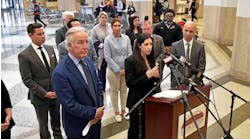The evacuation of a smoke-filled passenger train in a Hokkaido tunnel Friday night was delayed by a company requirement that fires be visually confirmed before action can be taken, it has been learned.
The accident occurred on the JR Sekisho Line of Hokkaido Railway Co. (JR Hokkaido) in Shimukappumura. After its fifth car derailed and apparently caught fire, the Super Ozora No. 14 express train made an emergency stop in the 685-meter-long Daiichi Niniu tunnel Friday night.
JR Hokkaido's operation manual requires that train staff visually confirm a fire before any steps can be taken, but the thick smoke that filed the train and tunnel prevented such confirmation.
Because the fire could not be seen, the train's 240 passengers were not immediately evacuated.
Forty of the passengers were taken to hospitals for treatment of burns and smoke inhallation, but there were no life-threatening injuries.
JR Hokkaido admitted there was a problem with its handling of the accident and said it would review its manual. The Land, Infrastructure, Transport and Tourism Ministry also said it will check the manual and investigate whether the company dealt with the accident appropriately.
According to JR Hokkaido, the operation manual requires visual confirmation of a possible fire when a warning light goes on in the driver's compartment. Upon confirmation, the manual instructs employees to lead passengers to safety.
The limited express train made an emergency stop in the tunnel at 9:56 p.m., and the warning light in the driver's compartment illuminated. A 60-year-old conductor in the fourth car contacted a command center at 10:07 p.m., saying, "We should get the passengers off the train and outside the tunnel" as smoke was filling the cars.
But the command center told him to wait and not open the doors for the time being because "in any case, the tunnel will be filled with smoke."
The conductor got off the train to determine the distance to the tunnel exit, while the driver, 26, also got off the train to check whether a fire had broken out. However, he could not see any flames due to the smoke.
A JR employee who happened to be on the train contacted the company's command center at about 10:30 p.m., saying, "Smoke's filling up the train, but I can't see a fire."
About the same time, passengers began to evacuate the train on their own, while employees assisted some of them.
JR Hokkaido finally confirmed there was a fire at 12:02 a.m. Saturday after receiving a report from the Hokkaido prefectural police. Investigators believe the casualties may have been much worse if evacuation of the train had not started until then.
JR Hokkaido says its manual was properly followed in the accident, but acknowledged there were problems with evacuation procedures in the event of a tunnel fireand pledged to review them.
The manual requires trains "to leave tunnels in case of emergencies and stop at a safe place."
When an unusual incident occurs on a moving train, a screen in the operator's compartment displays the instructions, "Stop immediately," or "Stop at the next station" depending on the nature of the incident. When part of the train becomes overheated, a warning light illuminates, and the manual requires the driver to immediately stop the train.
However, the warning light does not necessarily mean a fire has broken out. The manual therefore instructs the driver "to stop the train at a safe place and check the source of the heat."
JR Hokkaido manual unique
Unlike JR Hokkaido, other JR companies do not require visual confirmation of a fire.
Central Japan Railway Co.'s manual emphasizes the need to extinguish fires quickly even if they are difficult to see because of smoke. If the fire is not immediately put out, the crew must evacuate passengers to ensure their safety.
West Japan Railway Co. also requires the crew to evacuate passengers if a fire cannot be immediately extinguished.
All the companies urge drivers not to stop in a tunnel or on a bridge but to move a train to safer places in emergencies. However, there are no clear instructions of what to do when a train has stopped in a tunnel.
According to the transport ministry's Railway Bureau, there are no uniform rules or regulations concerning evacuations after railway accidents. Instead, each railway company must devise its own manual.
"The results of an investigation into the latest accident should be shared among railway companies," a ministry official said.
Train services between Shimukappumura and Shin-Yubari stations on the Sekisho Line resumed Monday--59 hours after they stopped due to the accident.
The Super Ozora No. 2 connecting Kushiro and Sapporo left Shimukappu Station at 9:16 a.m.
Copyright 2008 LexisNexis, a division of Reed Elsevier Inc. All rights reserved.
Terms and Conditions | Privacy Policy


